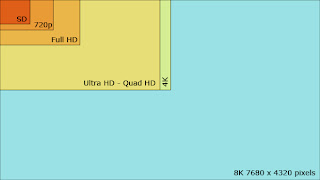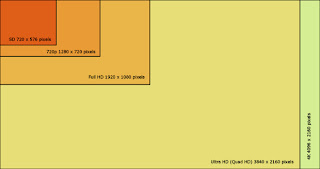CES 2013 saw a spate of HD displays, Full HD, 4K, 8K. It's time to return to these definitions of screens that can be confusing. And since a picture is worth a thousand words ...
The world of television is engaged in a race to the definition. Standard definition in Full HD through the 720p, have 4K, 8K Ultra HD and point the tip of their nose. Far from being a novelty CES 2013, the show has only confirmed a trend that manufacturers presents shots of prototypes and models being marketing (including Sony and LG).
All these terms refer to the definition of screens is their ability to display a certain number of pixels. The objective is clearly to provide better image quality. If the intentions are understandable and commendable. This race raises the issues before the availability of relevant content. If Sony ensures a bare minimum film "Ultra HD," but only in the United States, with the release of its 84-inch model (KDL-84X9005), the volume needed to ensure success of the Ultra HD is not still there. Not to mention a broadcast channels programs Ultra HD. Although a test channel has just been launched in Ultra HD, the French audiovisual landscape has barely see the arrival of six new HD channels TNT. Suffice to say that the migration process is slow, an understandable thing given the amount of investment required (to capture the diffusion through the installation, everything must be reviewed).
Formats galore
All these terms are not, however, necessarily very clear. Here is what they represent:
SD: standard definition 720 x 576 pixels, it is proposed that the DVD
720p: an intermediate format as an integral part of the HD (High Definition) with 1280 x 720 pixels it is much used by the VOD services (video on demand) to share their needs and less important bandwidths.
Full HD: With its 1920 x 1080 pixels, which is another definition of HD. The true, the full total, the proposed all current TVs. It is also the definition used by the Blu-ray, DVD and successor won the war against the other HD format: HD-DVD.
Quad HD - Ultra HD: 3840 x 2160 pixels, often mistakenly called 4K because it is a movie format of offering 4096 x 2160 pixels. The term Quad HD is the fairest because this definition has exactly four times more pixels than Full HD. But now we must use the term Ultra HD. The CEA (Consumer Electronics Association) is in fact designated as the official name for this display standard.
8K: Ultra HD is not there yet as his successor successor is already heated, remains to be seen what name will be officially awarded: Quad Ultra HD? Ultra Ultra HD ... This definition has at least 16 times more points than Full HD, and four times more than the Ultra HD.
It is a history of mathematics. The Ultra HD offers twice the horizontal and vertical lines that Full HD is four times more pixels in total. 8K twice more lines (always vertical and horizontal) that the Ultra HD, and therefore four times more lines than Full HD. A total of four times more pixels than the Ultra HD, and 16 times more than Full HD.
Here are two images, all these definitions represented proportionally.








.jpg)
Post a Comment